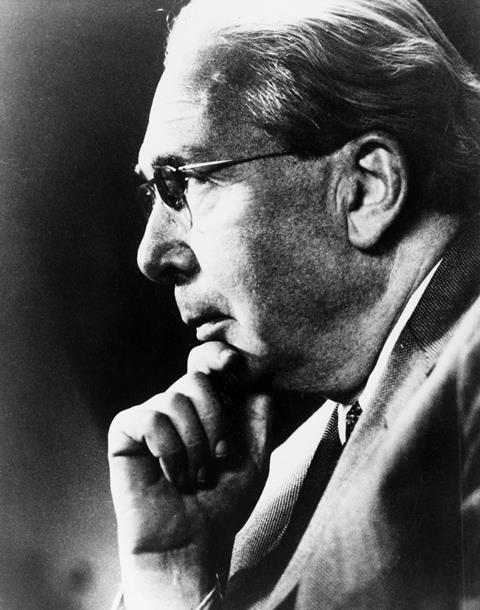A sad, though predictable, omission in the Oppenheimer blockbuster is the moment the nuclear age was born. No, not the 'I am become death' Trinity bomb test but the undramatic moment on 12 September 1933 when, while waiting to cross London's Southampton Row, the Hungarian theoretician Leo Szilard (pictured below) had a brainwave. Szilard realised that a reaction in which atoms emit neutrons becomes self-perpetuating if enough of these neutrons collide with atomic nuclei to release more neutrons: in the process liberating as energy the binding nuclear force.
Nine years on, in a squash court under a sports viewing stand in Chicago, the theory was demonstrated with the world's first nuclear reactor. A team including Szilard under exiled Italian physicist Enrico Fermi built it by stacking cylinders of natural uranium interspersed with blocks of a graphite moderator, which slowed down the neutrons to make the crucial collisions more likely. Control rods of cadmium, a hungry neutron absorber, regulated the reaction. (The film at least gives us a fleeting glimpse.)
The engineering was crude, but 'Chicago Pile-1' worked in principle identically to nuclear power plants today. The main difference is that CP-1 generated only about half a watt of heat energy. In power stations today gigawatts of heat energy is transferred by water or gas to a separate plumbing circuit which creates steam to turn the blades of a turbine connected to a generator like the alternator in your car.

Nuclear power stations are a proven, safe technology: the number of people who have been killed by western commercial nuclear power stations in their entire history is approximately zero. Their environmental footprint is a fraction of that of other types of electricity generator. If you're concerned about radioactivity, you'd be better off avoiding airline flights, secondary healthcare and visiting Cornwall than shunning nuclear power. As for waste, the nuclear industry is the only industry committed to cradle-to-grave management. Sure, radioactive half-lives can be long: but the lithium in your oh-so-green bike battery will be toxic for ever.
Nuclear is also the UK's only hope of keeping the lights on while meeting its legally binding 'net zero' carbon emissions target. The snag? The type of power stations we build today, and the way we go about building them, lead to commercially prohibitive costs. There is a better way - but getting there will require a complete change from the stop-start bumbling - involving the abandonment of successive generations of expertise and technology - which has characterised UK nuclear policy over the past 60 years.
For a taste of the current quagmire, it is worth reading the judgment of The Honourable Mr Justice Holgate two months back in a judicial review challenge to the decision to build a new plant at Sizewell in Suffolk. When following the case, recall that Sizewell has been a nuclear site since the 1960s; the currently operational Sizewell B plant, the country's newest at just 28 years old, was itself subject to 340-day public inquiry, at the time the longest and most exhaustive in history.
You might have thought that would settle any controversy about the continued use of the site, particularly given the pressing demands of net zero. Far from it, if the 55-page judgment in Together Against Sizewell C v Secretary of State for Energy Security and Net Zero is any indication. The challenge to the reasonableness of the Sizewell C (Nuclear Generating Station) Order 2022 was brought by a company set up by a local community group with about 280 supporters.
The objectors came up with seven grounds of challenge; the bulk of the judgment is concerned with the argument that the project's impact assessment missed out the need for a supply of potable water. When operating, according to the judgment, the power station will need about 2.8 million litres a day, roughly as much as 6,000 households. (This is entirely separate to the site's consumption of cooling water, which comes directly from the sea.)
The judgment notes that, while the application for planning consent did not mention the need for a permanent water supply, any uncertainty about Northumbrian Water's ability to supply it arose only subsequently; in the 'unlikely event' of the water company being unable to provide a solution, the reactor's operator would build a desalination plant. 'Plainly this is not a case where the promoter of a project has sliced up the development in order to make it easier to obtain consent for the first part of a larger project,' the judge concluded. There is 'no basis upon which the [developer's] evaluative judgment can be said to be irrational'.
At least this challenge identified a site-specific problem which needs to be tackled. The other grounds, which the judge dealt with more promptly, are more ephemeral, cutting directly across government policy. Of a claim that the developers should have considered alternatives to nuclear, the judge said this would imply that builders of wind or solar installations would have to consider going nuclear instead. The challenge was 'an illegitimate attempt to rewrite the government’s policy aims', as such a 'wholly inappropriate' use of the courts process.
The judge conceded that uncertainty remains about how far into the next century spent fuel will need to be stored at the site, but 'that is not the only uncertainty about the future'. As for a challenge based on the fact that the plant itself will emit greenhouse gases: 'Utterly hopeless and must be rejected'.
In one sense, the Sizewell C controversy is itself a dead end: the gigawatt-scale pressurised water reactor may be the last of its kind. Government policy, for what it is worth, is to cut the cost of nuclear by investing in 'small modular reactors'; prefabricated 470MW designs. In theory SMRs are supposed to be rolling off assembly lines within a decade. But if every installation, even at established nuclear sites, is subject to the same kind of legal challenges we have seen at Sizewell, it is hard to see that target being met. I have no doubt that my London neighbours, while all for net zero and keeping the lights on, would find numerous JR spanners to throw into any proposal for an SMR installation in Muswell Hill.
Even more remote is the prospect of Britain joining the race to develop the likely following generation of reactors: running on molten salt liquid fuel at close to ambient pressure and thus far cheaper to construct. That generation might be the final stage before fusion power becomes a practical possibility, but despite recent developments it would be unwise to bet too much on fusion yet.
In the meantime, what is needed is a recognition from all sides, particularly the green lobby, that the only way is nuclear. The House of Commons Science and Technology Committee made a start earlier this summer with a call for the government to set a clear plan, including setting out which decisions - for example on geological disposal of waste - must be made by which dates. The committee also suggested streamlining the regulatory process, for example taking lessons from the Covid-19 licensing programme.
But that kind of decision-making would tap a particularly scarce commodity: political courage in an election year.
Leo Szilard, who did more than anyone else to create the Manhattan Project and who, like Oppenheimer, agonised over a the consequences of the atomic bomb, died in California in 1964. On 12 September this year, you'll find me at the Bloomsbury traffic lights where he had his brainwave, raising a glass of Tokaji to his hopes of a world set free with atoms.
Michael Cross is Gazette news editor. He covered civil nuclear developments in Europe, Japan and the US for newspapers and specialist magazines over several decades




































8 Readers' comments